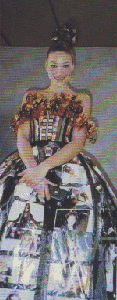 The Advanced Photographic System or APS was originally conceived by Kodak
as a way of revitalising the photographic market by making cameras cheaper
and simpler to use. The APS system was launched on 1st
February 1996 after more than 4 years of research and development. The
date was specially chosen to mark the 96th anniversary of the
launch of the first Kodak camera by George Eastman, which made photography
popular in the 20th century.
The Advanced Photographic System or APS was originally conceived by Kodak
as a way of revitalising the photographic market by making cameras cheaper
and simpler to use. The APS system was launched on 1st
February 1996 after more than 4 years of research and development. The
date was specially chosen to mark the 96th anniversary of the
launch of the first Kodak camera by George Eastman, which made photography
popular in the 20th century.
In the twenty years previous to the launch of APS, Kodak, who have a long tradition of bringing photography to the masses, introduced the 110 and disk format film cartridges. These formats failed to realise their full potential, partly due to the proprietary nature of the film which deterred other manufacturers from bringing competitive products into the market, and to the poor quality of the photographs caused by limitations of the lens and film technology of the time. These systems were, however, easier to use in terms of film loading and overall camera size because they used smaller format negatives and were supplied in custom "drop in" loading cartridges.
An alliance was formed in April 1992 between Kodak, Fuji, Canon, Minolta & Nikon, in order to spread the cost of developing the new APS system, to take advantage of the existing research and expertise of the individual partners and to ensure acceptance of the new system by the major photographic manufacturers, vendors and general public. The System Development Companies (SDC) or "big five" as they came to be known developed APS around a new film and cartridge system which would be smaller than current 35mm technology, provide simpler loading and handling, and produce good quality prints.
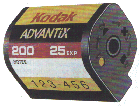 The APS specification is basically centred around the film and canister
which leaves the camera manufacturers free to choose which features of the
system they want to incorporate on their products. In its simplest terms,
APS film is smaller than 35mm, producing 30x17mm negatives (compared with
36x24mm for 35mm), with an aspect ratio of 1.76 as opposed to 1.5 for
35mm. The canister size has also been redesigned and reduced in size by
approximately a third. APS film has no visible leader and is designed to
be automatically fed onto the take up spool when the film is inserted into
the camera. The negatives are returned in the canister rather than as cut
strips and a contact sheet of all the photographs on the roll is supplied
along with the prints. Any exposure information and messages recorded by
the camera are printed on the back of the photograph. Behind these "simple"
ideas, however, lie a number of major developments which have made the APS
system possible. These technologies will be explored in greater detail in
this essay.
The APS specification is basically centred around the film and canister
which leaves the camera manufacturers free to choose which features of the
system they want to incorporate on their products. In its simplest terms,
APS film is smaller than 35mm, producing 30x17mm negatives (compared with
36x24mm for 35mm), with an aspect ratio of 1.76 as opposed to 1.5 for
35mm. The canister size has also been redesigned and reduced in size by
approximately a third. APS film has no visible leader and is designed to
be automatically fed onto the take up spool when the film is inserted into
the camera. The negatives are returned in the canister rather than as cut
strips and a contact sheet of all the photographs on the roll is supplied
along with the prints. Any exposure information and messages recorded by
the camera are printed on the back of the photograph. Behind these "simple"
ideas, however, lie a number of major developments which have made the APS
system possible. These technologies will be explored in greater detail in
this essay.
It was clear from a very early stage in the development of APS that a new material was needed for the film base. The new loading system meant that the film had to be strong and firm enough to cope with the rigours of being thrust out of the canister by a motor winder and hooked onto a take-up spool. The new, smaller canisters also created new limitations on the thickness and length of the film. A normal film strip with a thickness of approximately 115mm would have to be wound very tightly onto the spool which would form a permanent curl and damage the material. Reducing the size of the negative helped by reducing the overall length of the film strip but did not entirely solve the problem. Tests had also shown that the material normally used for 35mm film, Triacetate Cellulose (TAC), dramatically lost strength and robustness when reduced in thickness from 115mm.
In order to surmount these problems, an alternative material used in the manufacture of DAT tape, PolyEthylene Napthalate (PEN), was chosen for its thinness and strength. PEN has high planar characteristics which help to stop the negatives curling after being stored in the tightly wound canisters and is less prone to damage from cameras or photo finishing equipment. The thickness of the film base was reduced to around 90mm which allowed for a film strip length of 1570mm (40 exposures). The new film base is one of the key factors in the APS system which help to improve the overall robustness of the medium.
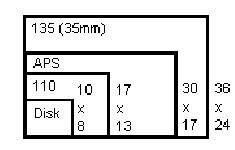
Using smaller negatives has many benefits, the most obvious being that the cameras can be made smaller. But there are more subtle advantages, for example, the focal length of the lens is smaller for a given magnification. This means that the lens is easier to manufacture and therefore cheaper. A shorter focal length means less distance required between the lens and the film plane saving more space. A smaller negative also implies that less light is needed for any given exposure when compared to 35mm. The net effect of this is to increase the speed (ASA) of the emulsion which by implication means that slower emulsions can be used for any given film speed when compared against the 35mm equivalent thus reducing the grain size and cost. The most important argument against small negatives is that the grain size or resolution of the film is generally too low to allow for enlargement beyond 10"x8".
Figure 4 - Relative Size of APS Prints
The APS specification allows for the printing of photographs in three formats - Classic (6"x4"), HDTV (7"x4") and Panoramic (10"x4"). The Classic and Panoramic formats are the same as those available with normal 35mm film. HDTV is a new format with an aspect ratio that is more pleasing to the eye as it is closer to the way humans naturally "frame" a scene. The HDTV aspect ratio should also match that of the new standard for television that photographs can be displayed using the full size of the television screen without any cropping.
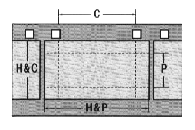
APS negatives have the same aspect ratio as HDTV prints and therefore require no cropping when enlarged to make a print. Classic and Panoramic prints however require different size negatives however, which can be fitted within the area of the HDTV format negative. This is a major advantage as it means that all three picture formats can be stored within one standard frame size on the film and allowing photographs to be taken in different formats on each film rather than using only one format per roll.
To give the consumer maximum flexibility, all photographs taken on APS film use the full area of the negative i.e. HDTV format. A marker placed on the film when the picture was taken tells the lab which format to print the image. The consumer can instruct the lab to override this marker and make the print in another format making the system very flexible. HDTV format is expected to be very popular with consumers and to become a new standard format for photography.
The table below gives an indication of the negative size, paper print size and magnification factor required to achieve the different formats.
|
Type |
Ratio |
|
|
inches(mm) |
|
|
|
|
|
|
|
|
|
|
|
|
|
|
|
|
|
|
|
|
|
|
|
|
Market research showed that APS had to be capable of delivering as a minimum the same picture quality as 35mm for standard prints. Due to the smaller format negatives, a larger magnification factor is required for APS compared to equivalent 35mm prints (see figure 6) therefore reducing the quality of the print using standard emulsions. In order to keep the print quality as high as possible, new light sensitive emulsions had to be developed such as T-Grain from Kodak and Super Uniform Fine Grain from Fuji. These emulsions tend to have smaller and more regular grains than that used in consumer 35mm film. Other advancements which help to keep the picture sharp and improve light sensitivity include diffraction minimisation and reduction in the thickness of the emulsion layer. The net result of the application of all these technologies is to allow the negatives to be enlarged further before the final image looses definition and becomes grainy.
Colour balance, contrast and brightness issues are the main problems that face photo finishers when making prints. Ideally each print should be processed by hand so that the optimum quality can be realised, but to cut costs and increase speed and volume, the labs use automatic equipment which analyse the negatives and then decide on the most appropriate settings. The process can be improved however, by providing exposure and other appropriate data about the photograph to the lab. The information required to do this is stored digitally on the film which has a special, optically transparent, magnetic coating. The PEN base is basically the filling in the sandwich with the magnetic coating on one side and the light sensitive coating on the other. The concept and specification for storing photographic data, digitally on the film, is called Information Exchange or IX and it is a core part of APS.
Although the film surface is completely covered in a magnetic coating and supports 10 horizontal data tracks, only two tracks, located at the edges of the film and away from the picture area are used. This is because there is still some risk of damaging the negative with the head which is of a similar construction to that of a cassette recorder. Kodak believe that there will be number of advances in the next few years which will reduce or eliminate this potential problem. When the technology permits, the unused tracks will be made available for use in camera and printing equipment as standard.
 A
number of third party products have started to use these tracks already,
however, such as the Fuji AP1 film viewer. This machine accepts the
developed APS canister and displays the pictures on a television screen.
The consumer can add accompanying text, zoom and crop instructions which
will be stored on the film using the IX system on the unused tracks.
A
number of third party products have started to use these tracks already,
however, such as the Fuji AP1 film viewer. This machine accepts the
developed APS canister and displays the pictures on a television screen.
The consumer can add accompanying text, zoom and crop instructions which
will be stored on the film using the IX system on the unused tracks.
Basic data such as print format can be stored optically on the film thus reducing the cost and mechanical complexity of APS cameras. This enables camera manufacturers to make cheaper cameras which support the basic features of APS. The amount and type of IX information stored on the film is dependant on the specification of the camera being used as the manufacturers can implement the specification to varying degrees.
The APS film strip has a number of identification, data storage areas and features which are highlighted in the figure on the next page. The film does have a leader which is used to locate and hook onto the take up spool however, the leader is never visible as the film is completely contained within the canister while not loaded in a camera. There are two perforations per frame making metering and frame location very accurate. One of the benefits of accurate metering is that APS film can support mid roll changes of film, that is, the removal of a partially used film and reloading it at a later stage without loosing or double exposing a frame. There are however, very few cameras on the market which have this feature enabled. The optically stored data for each frame can be overlaid with the magnetic data thus saving space. This feature is possible because the optical and magnetic data is recorded on different sides of the film and the reading and writing of the magnetic data use no optics.
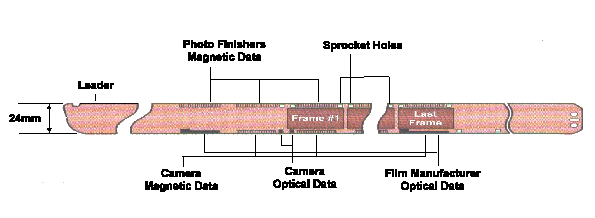
The APS cartridge was completely redesigned as the normal 35mm canister was not able to stand up to the new rigours and mechanical processes required for the new format. The new canister is oval in shape with a shutter over the film door instead of the usual felt strips on 35mm canisters. The spool sits flush with the top surface increasing the compactness and robustness of the design. The label has a bar coded and numeric format serial number which is used to track and match the canister, film and consumer while the film is being developed.
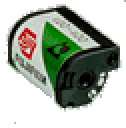 On
one end of the canister is a "data disk" which is the equivalent
of DX coding on a normal 35mm camera. The data disk stores the film speed,
number of exposures and exposure latitude for the film. Like the optical
data storage mentioned earlier, this is another mechanism which simplifies
APS cameras mechanically and makes use of existing technology. The
opposite end of the canister has a basic film status indicator. A white
marker appears in one of the four symbols indicating the current state of
the film inside the cartridge. The four positions are defined as follows -
On
one end of the canister is a "data disk" which is the equivalent
of DX coding on a normal 35mm camera. The data disk stores the film speed,
number of exposures and exposure latitude for the film. Like the optical
data storage mentioned earlier, this is another mechanism which simplifies
APS cameras mechanically and makes use of existing technology. The
opposite end of the canister has a basic film status indicator. A white
marker appears in one of the four symbols indicating the current state of
the film inside the cartridge. The four positions are defined as follows -
| 1 - (circle) - unexposed film 2 - (semicircle) - partially exposed film 3 - (cross) - fully exposed film 4 - (square) - developed film |

|
 The
cartridge is designed to be dropped into the camera. Once the film door is
closed, the camera will automatically open the shutter on the cartridge
and feed the film onto the take up spool. When the film has been used, or
is ejected from the camera, the appropriate symbol is set on the top of
cartridge, the film rewound and the shutter closed. The negatives are
returned to the consumer in the cartridge after processing and developing.
The cartridge therefore becomes a storage medium which provides protection
for the negatives as well as easy reference via the serial number.
The
cartridge is designed to be dropped into the camera. Once the film door is
closed, the camera will automatically open the shutter on the cartridge
and feed the film onto the take up spool. When the film has been used, or
is ejected from the camera, the appropriate symbol is set on the top of
cartridge, the film rewound and the shutter closed. The negatives are
returned to the consumer in the cartridge after processing and developing.
The cartridge therefore becomes a storage medium which provides protection
for the negatives as well as easy reference via the serial number.
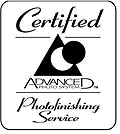
A number of changes have had to be made at the photographic labs in order to meet the specifications for APS. Labs that meet these standards can be certified and use the relevant APS logo in their advertising. The certification is intended to be an assurance for the consumer and implies that the lab can develop and print APS films to a minimum standard and provide as a basic service the following -
APS film is developed in standard C41 colour chemistry and can use the same film processing equipment as 35mm film. In order to simplify the mechanics of the process, the APS film is generally removed from the canister at the beginning of the process and loaded into bulk cartridges before being developed in the film processor unit. The processed negative strip is then matched with its original canister and reinserted.
It is at the printing stage however, where the real enhancements have been made to the processing system. The printing system has to be able to read the IX information that is stored both optically and magnetically on the film in order to print the picture correctly. Standard 35mm printing systems can print the APS negatives but none of the advanced features of APS would be available and a lot of manual intervention would be required.
The primary use of the IX system is to provide instructions to the Photo Finishing Lab on how to print each individual picture. The typical kind of information stored about each print is the format, date, title, number of copies, aperture, shutter speed, film ISO rating, exposure compensation, lens focal length, maximum focal length of the lens and PQI (Print Quality Information).
When a print is made from a negative using an automatic system, the printer exposes the paper for an average print, that is, one with an average tonal value of 18% grey. This system produces good results on average but a high proportion of prints come out incorrectly because they are taken under complex lighting conditions. Newer systems use an evaluative metering system which analyses the tonal value from a number of sectors on each negative and these results are used to set the overall exposure. The printing machines are also able to analyse each negative as it is processed and adjust the exposure accordingly. While these systems offer a larger degree of automation and accuracy, they still do not give reliable results because they are easily tricked by difficult lighting conditions like backlighting.
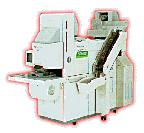 The
PQI (Print Quality Information) stored on APS film is intended to reduce
the margin of error in the printing equipment by providing detailed
information about the exposure. The simple philosophy behind PQI is that
the more information about the scene being photographed that can be
supplied to the printer, the more accurate or faithful the print will be.
The PQI information that can be generated by the camera includes cartridge
load direction, magnification, flash fire, flash exposure, camera
orientation, back light, metering range, subject brightness, artificial
illuminate etc. Some of the functions like cartridge load direction
may seem pretty esoteric but they are important as they help define the
orientation of the horizon and the picture. Most pictures will have a
range of tones which vary from light at the top to dark at the bottom
corresponding to the transition from sky to ground. If the tonal range is
reversed because of the orientation of the film in the camera, and the
printing system is not aware of this, the exposure will be set incorrectly
as the assumption will be that the photograph has a dark sky. PQI is an
optional feature which can be implemented to varying degrees by the camera
manufacturers to enhance their products.
The
PQI (Print Quality Information) stored on APS film is intended to reduce
the margin of error in the printing equipment by providing detailed
information about the exposure. The simple philosophy behind PQI is that
the more information about the scene being photographed that can be
supplied to the printer, the more accurate or faithful the print will be.
The PQI information that can be generated by the camera includes cartridge
load direction, magnification, flash fire, flash exposure, camera
orientation, back light, metering range, subject brightness, artificial
illuminate etc. Some of the functions like cartridge load direction
may seem pretty esoteric but they are important as they help define the
orientation of the horizon and the picture. Most pictures will have a
range of tones which vary from light at the top to dark at the bottom
corresponding to the transition from sky to ground. If the tonal range is
reversed because of the orientation of the film in the camera, and the
printing system is not aware of this, the exposure will be set incorrectly
as the assumption will be that the photograph has a dark sky. PQI is an
optional feature which can be implemented to varying degrees by the camera
manufacturers to enhance their products.
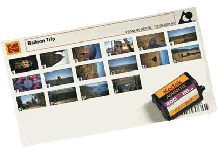
The other functions which the print processor has to do are to back print the IX information, optionally print the title and date information on the front of the photograph and create an index print. The index print is like a contact print and consists of an HDTV thumbnail image of each photograph along with the crop lines for the format that was selected when the picture was taken. The index sheet will also have the serial number of the film that it was printed from and any date information that was recorded.
APS film is manufactured by a number of companies however the two leading brands appear to be Kodak Advantix and Fuji Nexia. Currently only ASA 100, ASA 200 and ASA 400 print films are available in the UK. While film is relatively easy to get in most chain High Street retailers like Dixons, there are still APS deserts around the country. It is worth noting that at present, APS film and cameras are only available in the UK, USA, Japan and a handful of other countries while 35mm film and services are relatively easy to find worldwide. While it may be argued that this is a drawback for APS, it should be remembered that the system is only a year old and that it does take a number of years to develop a global market. The SDCs will certainly ensure that the market for APS will keep growing and as the popularity of APS increases, film supplies and services will become more easily available both in the UK and worldwide.
There are currently no APS slide films available in the UK although Fuji does make some for sale in Japan. There are a number of problems associated with slide film which are not catered for in the APS specification. For example the negatives would have to be separated from the canister, cut up and mounted thereby making the IX information unreadable. Another issue is caused by the slide mounts themselves which will have to be made in classic, HDTV and panoramic formats or in HDTV with special masks applied in order to view the pictures in the correct format. A general problem with slide film is that it has a small exposure latitude, that is, the amount of error allowable in judging the exposure. A lot of the cheaper APS and 35mm cameras rely on the wide exposure latitude of print film to compensate for limitations in the metering system and more controll of the shutter speed and aperture. Slide film is therefore impractical for use on the cheaper, and more basic models of camera.

In fact many of the benefits of slide film can be achieved by using devices like the Fuji AP-1 and the Canon IP100 which as mentioned earlier, display an image scanned from the APS negatives on a television screen. Colour reproduction should be faithful as there is no printing process and picture quality should be good as long as a high resolution scanner is incorporated within the device.
Developing and Processing (D&P) is currently only available through a handful of labs with many reputable High Street labs and shops acting as agents. The cost is generally between 50% and 100% more than 35mm for the same service e.g. overnight processing and no retailers appear to offer one hour processing. There tends to be two pricing schemes employed, that is, a flat rate for any format or a flat rate for classic prints only with a surcharge for HDTV and Panoramic prints. The high cost of D&P is thought to be due to the amount of investment required to re-equip the labs, however, only some of the equipment has to be changed and the new equipment will work with both 35mm film and APS making it much easier to recoup the initial capital outlay. It is hoped that as the system gains popularity that the prices will drop however this is a somewhat circular argument as the high cost of developing is likely to deter consumers from investing in APS.
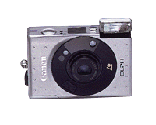 Although
the APS system was launched in February, the film and camera products were
not available in any quantity for some months. By May, most of the big
camera manufacturers were able to ship compact style APS cameras and
during the summer, Canon, Minolta, Olympus and Fuji released APS SLR
models. There is now a very wide range of camera equipment on the market
from single use cameras to SLRs with a full range of lenses offering a
variety of features based on the APS specification. A number of
manufacturers have complemented the new technology by breaking the usual
design conventions and producing cameras in a variety of shapes and
colours. The Canon Ixus (Elph in the USA) is the smallest APS camera on
the market and it has won numerous awards for its styling and features.
The Ixus is one of only two cameras selected by the Design Centre in
London as an example of good design.
Although
the APS system was launched in February, the film and camera products were
not available in any quantity for some months. By May, most of the big
camera manufacturers were able to ship compact style APS cameras and
during the summer, Canon, Minolta, Olympus and Fuji released APS SLR
models. There is now a very wide range of camera equipment on the market
from single use cameras to SLRs with a full range of lenses offering a
variety of features based on the APS specification. A number of
manufacturers have complemented the new technology by breaking the usual
design conventions and producing cameras in a variety of shapes and
colours. The Canon Ixus (Elph in the USA) is the smallest APS camera on
the market and it has won numerous awards for its styling and features.
The Ixus is one of only two cameras selected by the Design Centre in
London as an example of good design.
APS cameras and services are mostly available through Dixon's, Jessop's and a few other High Street stores who embraced the new technology with open arms and spent considerable sums of money marketing the products and services. There were also a large number of APS sceptics who had decided to wait and see how the market developed. Camera and film availability at launch was minimal and consumer confidence in the system was not boosted by the length of time it took for the manufacturers to bring products to market. It took almost six months for the full range of cameras, films and D&P labs to become available. Many big name stores such as Boots have only decided to carry APS relatively recently which is a positive sign as it indicates that the APS market is still growing and that the retailers feel confident about the technology. Conversely, the delay in acceptance helped to suppress the growing market by reducing the availability of APS and making consumers cautious.
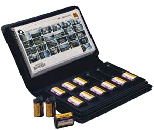 While
consumers generally expect to pay higher prices for new technology, the
increased cost of APS films and D&P over the 35mm equivalents has had
a negative effect on the marketplace. The APS cameras however appear to be
competitively priced in most cases against their 35mm equivalents and
there is now a growing range of ancillary products which are being
marketed to support the system e.g. new albums which can take the new
format, cases to store the APS cartridges etc. There has been little or no
drop in the price of APS equipment since the system was launched which
would imply that there is either healthy consumer demand or supply
problems.
While
consumers generally expect to pay higher prices for new technology, the
increased cost of APS films and D&P over the 35mm equivalents has had
a negative effect on the marketplace. The APS cameras however appear to be
competitively priced in most cases against their 35mm equivalents and
there is now a growing range of ancillary products which are being
marketed to support the system e.g. new albums which can take the new
format, cases to store the APS cartridges etc. There has been little or no
drop in the price of APS equipment since the system was launched which
would imply that there is either healthy consumer demand or supply
problems.
Although APS competes with 35mm in some arenas of the photographic market it is not intended to be a direct replacement. APS is primarily aimed at the consumer market where users need a simple system which produces good results. In many ways, APS is a return to the philosophy of George Eastman who simplified photography and made it easily accessible to the masses. Many of the technologies developed for APS are now starting to filter through to 35mm, for example Kodak Ektar film now uses Kodak's APS T-Grain technology to offer fine grain fast film. A number of D&P labs offer index prints as an optional service on 35mm film as well as back printing of the film serial number, frame number, processing date and Lab ID. While APS will definitely be responsible for end of some film formats like 110 and disk, 35mm will have the biggest share of the market for some years to come and its future seems very safe at present.
The APS system is therefore a marriage of technologies which the "big five" hope will fire the imagination of the public, produce good quality pictures, simplify cameras from a user perspective and encourage the use of photography. On paper, APS does seem to live up to these claims but on the whole, it has failed to live up to the high expectations that were generated when the system was launched.
On a final note, Kodak have recently announced that they will be relaunching the APS system in the coming months and it remains to be seen what special bundles and pricing will be on offer to help promote the system from both the manufacturers and D&P Labs.
Copyright & Credits
| Figure 1 | - | Carla Bruni @ APS launch wearing a dress made from APS Prints © Amateur Photographer 10/2/96 |
| Figure 2 | - | APS Film Canister © Amateur Photographer 10/2/96 |
| Figure 3 | - | Relative Size of different Negatives Formats © Photofinishing Planning Guide for the Advanced Photo System - System Developing Companies |
| Figure 4 | - | Relative Size of APS Prints © http://www.fujifilm.co.jp/usa/aps/smartcity/f-better.html |
| Figure 5 | - | APS Negative showing crop lines for different formats © Fujifilm Imaging & Information Fujicolor Nexia- Ref No AB-610E(SK-96-08-DT-MW) |
| Figure 6 | - | Table showing negative and paper sizes for APS © Fujifilm Imaging & Information Fujicolor Nexia- Ref No AB-610E(SK-96-08-DT-MW) |
| Figure 7 | - | Comparison of Fuji Grain Crystals © Fujifilm Imaging & Information Fujicolor Nexia- Ref No AB-610E(SK-96-08-DT-MW) |
| Figure 8 | - | Fuji AP1 Film Viewer © http://www.fujifilm.co.jp/usa/aps/smartcity/f-better.html |
| Figure 9 | - | APS Film Strip Format © Fujifilm Imaging & Information - MinilabGuide - Ref No. LB-505ER(SK-96-07-AS-MW) |
| Figure 10 | - | APS Canister End (Data Disk) © http://www.fujifilm.co.jp/usa/aps/smartcity/f-better.html |
| Figure 11 | - | APS Canister End (Status Indicator) © Amateur Photogropher 10/2/96 |
| Figure 12 | - | Drop in Film Loading © Canon Ixus Brochure - Ref No.ZC1-0402-ENG-0396 |
| Figure 13 | - | APS Certified Lab Logo © http://www.fujifilm.co.jp/usa/aps/smartcity/f-better.html |
| Figure 14 | - | Fuji SFA258 APS Print Processor © http://www.fujifilm.co.jp/usa/aps/smartcity/f-better.html |
| Figure 15 | - | APS Index Print © http://www.kodak.com/homePage.shtml |
| Figure 16 | - | Canon IP100 © Canon Ixus Brochure - Ref No.ZC1-0402-ENG-0396 |
| Figure 17 | - | Canon Ixus © Canon Ixus Brochure - Ref No.ZC1-0402-ENG-0396 |
| Figure 18 | - | A Selection of APS Cameras © www.kodak.com, © www.fujifilm.co.jp/usa/aps/smartcity & © www.usa.canon.com |
| Figure 19 | - | Kodak Memory Keeper © http://www.kodak.com/homePage.shtml |
With thanks to Henry Reid @ Kodak, Canon & Fuji Films for their help
and assistance.
Bibliography
Amateur Photographer 10/2/96
http://www.kodak.com/homePage.shtml
http://www.fujifilm.co.jp/usa/aps/smartcity/f-better.html
Canon Ixus Brochure - Ref No.ZC1-0402-ENG-0396
Canon Essential Guide to the Advanced Photo System
Fujifilm Imaging & Information - MinilabGuide - Ref No.LB-505ER(SK-96-07-AS-MW)
Fujifilm Imaging & Information - Fujicolor Nexia- Ref No AB-610E(SK-96-08-DT-MW)
The Complete Guide to the Advanced Photo System - Practical Photography Suplement
Photofinishing Planning Guide for the Advanced Photo System (Supplement) - Published by the System Developing Companies
Miscellaneous Sales Promotion Literature